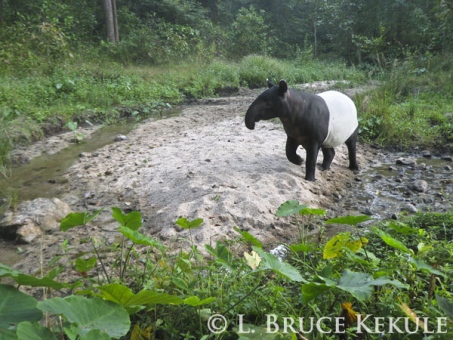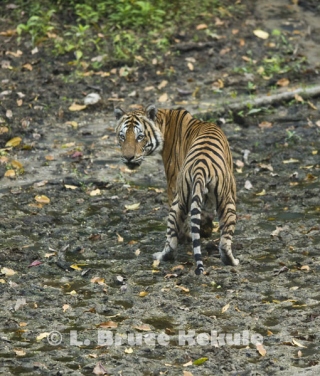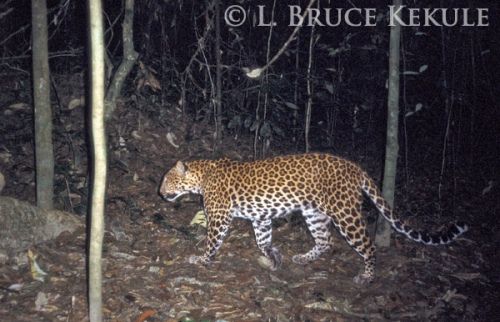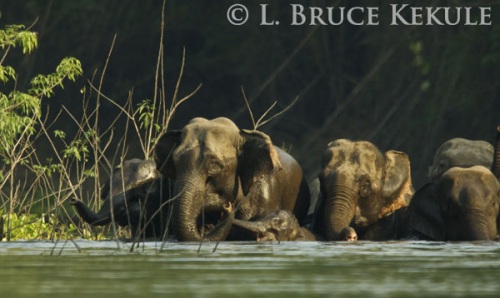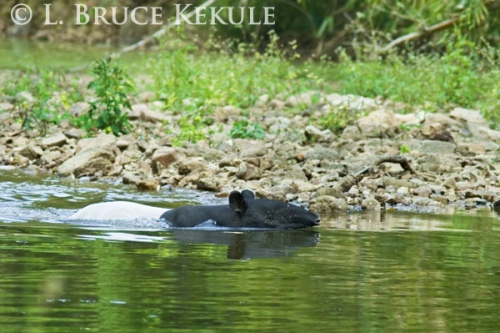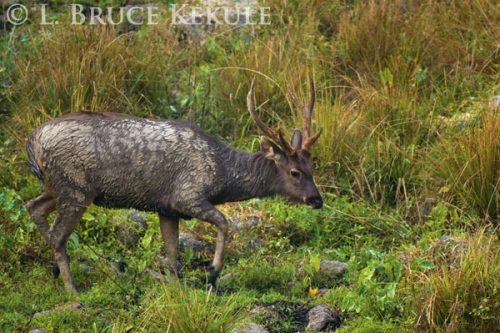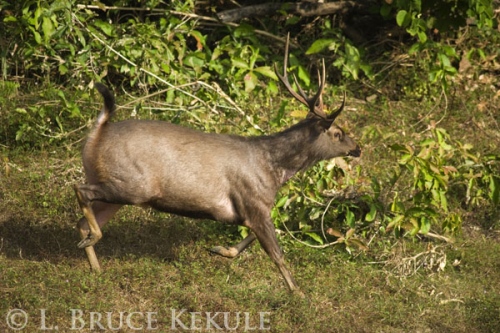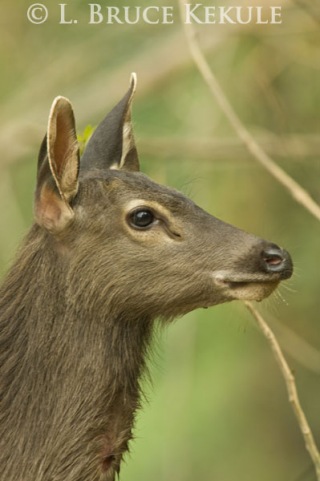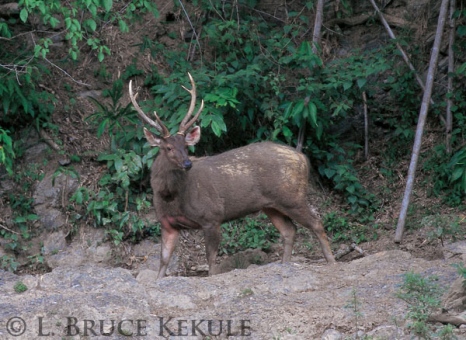Archive for February, 2011
Thailand’s Big Seven
WILD SPECIES REPORT
Elephant, gaur, wild water buffalo, banteng, tapir, tiger and leopard
Large Mammals in the Kingdom and the amazing biodiversity of Asian mega-fauna
Asian tapir camera-trapped in Huai Kha Khaeng
The term Big Five has always been recognized as an African thing with elephant, rhino, buffalo, lion and leopard making up the group. In fact, the hippo and the Nile crocodile should also be included as the most awesome animals on the African Continent. These large creatures have always fascinated people interested in nature.
The Big Five was hunting terminology for bagging these beautiful creatures with a gun, and then showing off the trophies and hunting photographs in their homes or offices to family, friends and associates. To come face to face with these sometimes ill-tempered beasts, mostly on the ground, was the ultimate test for the affluent hunters who visited Africa, and was the Holy Grail if they managed to bag all of them, so to say.
Young bull gaur in Khlong Saeng Wildlife Sanctuary
The ‘black-mane lion’ of the Maasai Mara in Kenya was one of the most sought after trophies and at the top of the sportsman’s list. However, hunting and killing of wild animals has somewhat gone out of fashion for most people around the world but it does continue on a limited scale. Those countries in Africa that still allow the huntsman an opportunity to take a trophy are few, and the cost is astronomically expensive plus the negative aspect of the sport, and the killing of these big beasts.
Last year I made a trip to Kenya and managed to bag the Big Five photographically. It was an amazing experience that is etched in memory. But it was from the safety of a safari van as the regulations in the parks and reserves are very strict about leaving the vehicle. But the thrill of seeing and photographing Africa’s wild mammals, birds and reptiles is an amazing experience, and one I recommend to anyone interested is seeing or photographing nature up close.
Bull elephant in Sai Yok National Park
Southeast Asia is also one of the world’s great wildlife treasure houses and maybe not as large or grand as Africa, Thailand’s Big Seven still flourish in a few of the larger protected areas in the Kingdom. This includes elephant, gaur, wild water buffalo, banteng, tapir, tiger and leopard. There is only one place on the planet that has all seven and that is Huai Kha Khaeng Wildlife Sanctuary in Uthai Thani province in the central-west.
A hundred years ago, two species of rhinoceros (Javan and Sumatran) were found in the large forests around the country but unfortunately were completely decimated before the protected areas came into being. A short fifty years ago when Khao Yai National Park was established, the last few stragglers were hunted down and that was the end of rhino in Thailand. Killed for their horns and sold to Chinese medicine dealers and Arab knife makers (used for dagger handles), it was a sad ending to some very captivating mega-fauna.
Banteng bull in Huai Kha Khaeng
Someone in Huai Kha Khaeng once coined the phrase Thailand’s Big Seven and at one time, there were loads of photographs of all these beautiful animals from the sanctuary all over the walls at the Seub Nakhasathien meeting hall in the headquarters. Most of the original photos are now gone but time does moves on. Most up on the walls now are of conservation and research projects, and rangers at work that is also good. Many school children come to this retreat to pay respect to Seub at his spiritual home, and to learn about nature and his life, and the sacrifice he made for Thailand.
After 15 years of visiting and photographing wildlife here including the Big Seven on film and digital, I can say this place is the Kingdom’s finest protected area. The sanctuary is without doubt, one of the best wildlife havens in Southeast Asia, and the world for that matter. However, other parks and sanctuaries have some of the Big Seven but are lacking the buffalo.
Wild water buffalo cows in Huai Kha Khaeng
After publishing individual Wildlife Species Reports in the Bangkok Post on all theses animals over the last couple of years, an up-dated review is warranted. As we forge ahead into the 21st Century, it is apparent these marvelous creatures and protected areas are under serious threat. The more people at all levels of society are educated about Thailand’s natural resources, the better the chances for survival into the future.
Indochinese tiger in Huai Kha Khaeng
This should be the highest priority for the government and private sector. Old out-dated laws and regulations are hampering conservation efforts and need a serious revamp. Wildlife crime is on the increase and concerted efforts to improve protection and enforcement is unfortunately, a bit slow in coming.
Leopard camera-trapped in Kaeng Krachan National Park
Budgets, funding and more rangers and personnel are needed. Transparency is also a must with the national parks and wildlife sanctuary budgets so money is used properly and efficiently, and corruption stamped out completely. Now that will be a tough nut to crack. It is hoped this draconian situation will change, so the Kingdom’s natural heritage will continue to survive in today’s world.
Thailand’s Big Seven
Asian Elephant: Elephas maximus
Asia’s largest terrestrial mammal is slightly smaller than its African cousin but still a huge beast of the forest, and approximately 2,000 survive in the wild of Thailand. These giant herbivores create trails to feeding grounds, mineral licks and migration routes through large tracks of forest. They are a flagship species for conservation.
In the old days, the genetic survival of the elephant depended on its ability to mix with other herds sometimes a long way away. Unfortunately, roads and human settlements have disrupted migration routes, and the poaching of large bulls with big ivory has affected the elephant’s natural breeding ability. As their numbers in the wild diminish, the Thai people should exert more pressure on the ‘powers-to-be’ the need to improve protection and enforcement as it’s number one priority.
Gaur: Bos gaurus
Gaur are wild forest ox and the largest bovid in the world standing 1.7 meters at the shoulder weighing close to a ton for mature bulls. These even-toed ungulates still survive in some protected areas but are in serious decline. It is now estimated about 1000 remain in Thailand. However, some reserves have gaur breeding in fairly good numbers like Huai Kha Khaeng and Thung Yai Naresuan forest complex allowing them to actually increase in number if there is adequate protection.
These enormous beasts live in herds but also become solitary, primarily the males. But I have also seen and photographed mature female gaur alone. Mineral deposits play a very important role in the lives of these wild cattle as does thick forests and steep mountainous terrain with abundant water resources. Their future depends whether they are protected to the fullest extent. Unfortunately, their beautifully curved horns are highly sought after by poachers and people who covet trophies.
Wild water buffalo: Bubalus arnee
These low-slung beasts are certainly the most fearsome of all the wild bovid family in Asia. Once upon a time, they were found all over Thailand in swamps and alluvial rivers. In the old days, wild buffalo were rounded up for domestication and hence disappeared from everywhere except Huai Kha Khaeng where the last wild herd now lives. Their numbers are small and it is estimated that 50-60 thrive in the southern section of the sanctuary.
Human expansion throughout Thailand over the last couple of centuries and the use of this beast of burden was the wild buffalo’s demise. Most were tamed for farming and transportation but the last herd was saved just in the nick of time when the wildlife sanctuary was created in 1972. This herd however is continually threatened with an ever-increasing human population just outside the sanctuary, and the mixing of domestic with wild buffalo by the local farmers is a serious problem with possible transmission of cattle disease like anthrax or foot and mouth. Hunting them for their trophy is also a serious threat.
Banteng: Bos javanicus
Banteng are common ancestors to Bos bibos, wild cattle that inhibited the vast plains of Asia during prehistoric times. Fossil finds of banteng from the Pleistocene epoch in Bali and Java are common. These beautiful red wild cattle thrive well in only two places in Thailand and it is estimated about 250 individuals live in Huai Kha Khaeng in the west, and another 80 or so in Khao Ang Rue Nai Wildlife Sanctuary in the east.
There are a few other small pockets where banteng is still found but these are not sustainable and they will eventually disappear. Protection of their remaining habitat is the most important element. Their horns and meat as with gaur and buffalo are also sought after. Banteng prefer open lowland deciduous forest and are easy pickings for poachers with jeeps, spotlights and rifles. As creatures of habit like gaur, they also need to visit mineral deposits and hence, fall victim to determined hunters.
Asian Tapir: Tapris indicus
The family to which the modern tapir belong, Tapridae, can be traced back as far as Early Oligocene times, about 40 million years ago. Tapir evolved from small hoofed mammals. These odd-toed ungulates eat only vegetation. It is also the largest of the world’s four species. They are solitary creatures unless breeding. The young have longitudinal pale striped bodies but as they grow older, the Asian tapir has a distinctive two-toned black and white coloring.
At one time, tapir could be found throughout the western Tenessarim Range all the way down the Thai Peninsula to Malaysia. That has all changed now due to roads, highways and human settlements that have divided up the country. However, it is estimated that maybe 300-400 still thrive in Thailand. Tapir are poached for their meat in some areas.
Indochinese Tiger Panthera tigres corbetti
The tiger is probably one of the most revered creatures in the animal kingdom and is a flagship species for wildlife conservation. As Asia’s apex predator, it present status is not good. Its current standing is at an all-time low with about 200-300 left in Thai forests if that. Where there are abundant prey species and good protection with no poaching, the big cat will survive and breed.
The Western Forest Complex with Huai Kha Khaeng and Thung Yai at the core is the best tiger habitat in Thailand, and Thap Lan and Pang Sida national parks in the Northeast is Thailand’s second best tiger reserve. Another good location for tiger is Kaeng Krachan and Kui Buri forest complex but their numbers are low here.
Tiger bones are one of the most sought-after wildlife commodities and the pelt is now usually left to rot, as it is very heavy when fresh and difficult to take care of. The Chinese medicine trade is the number one reason tigers have dropped drastically in numbers worldwide, and this responsibility rests directly on China’s shoulders as the tiger moves closer and closer to extinction. They have been unable to stop the flow of wildlife black-market trade and one day soon, this magnificent predator will vanish forever. The world must bring pressure to bear on all countries that use primitive medical remedies at the expense of a wild species
Leopard: Panthera pardus
The leopard is probably much better off than the tiger due to its survivability, size and tolerance to humans. Exact numbers are not known due to its very stealthy character but there are probably 1000 or more still living in the western part of Thailand all the way down to Malaysia. For some reason, they are not found in the East or the Northeast.
Leopard can survive on much smaller animals and will even take farmer’s cattle, pigs, dogs, cats and chickens. Their ability to blend in and being primarily nocturnal, one hardly ever sees them. Both color phases (yellow and black) are found and they are solitary except during breeding season. Their bones are also taken and the pelt is in demand. Leopards like the tiger are susceptible to poisoning of carcasses used by poachers.
In closing, only two things can save the Big Seven plus all the other animals and ecosystems they live in, and that is they must be protected from the onslaught that carries on day in and day out. Stories are popping up in the newspapers about poachers caught with guns and animal carcasses, and it seems to be a hot issue at the moment. These perpetrators need to be removed from local communities and sent to prison setting precedence so others will stay out of the protected areas.
Secondly, wildlife conservation education must be administered into all levels of society. Thailand’s wildlife and forests have evolved over millions of years and are far too important. Awareness, strict enforcement, better funding and management plus up-graded laws are the key!


